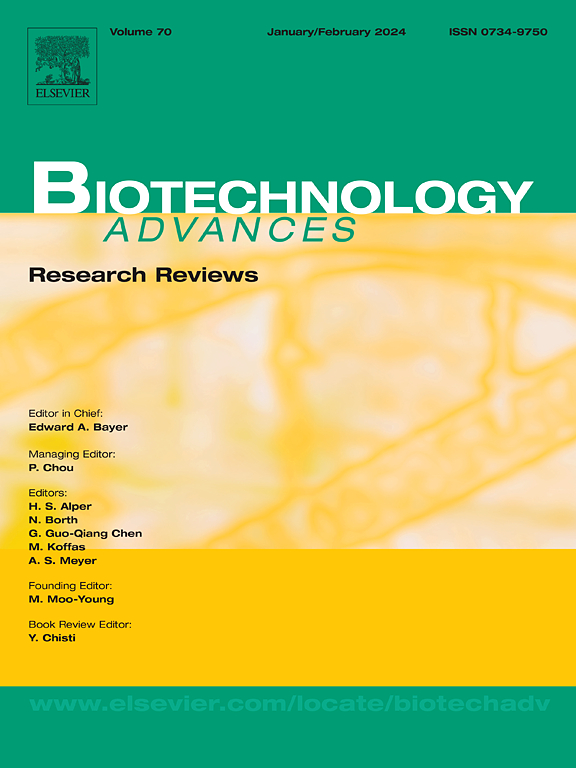博氏酵母菌的基因工程:增强益生菌和治疗应用的工具、策略和进展
IF 12.5
1区 工程技术
Q1 BIOTECHNOLOGY & APPLIED MICROBIOLOGY
引用次数: 0
摘要
博拉氏酵母菌是一种益生菌酵母,在临床试验中得到了广泛的研究,它被用来治疗几种肠道疾病。它的高存活率和分泌重组蛋白的能力,使博氏沙门氏菌成为肠道中感兴趣的分子的有吸引力的输送血管。尽管基因工程的自然作用机制仍未被完全理解,但它提供了合理设计将感兴趣的分子输送到肠道的优势。作为酵母菌,博氏酵母可以产生具有翻译后修饰的复杂蛋白质,与细菌益生菌相比具有优势。此外,抗生素可以与这种酵母共同施用,增加肠道停留时间,提高对人体健康的积极影响。本文综述了博氏弧菌基因工程的研究进展及其应用。这种酵母与酿酒酵母的相似性使得开发CRISPR-Cas9、质粒表达系统和基因整合技术等工具成为可能,这些工具允许对博氏酵母进行修饰。这些遗传工具和修改是根据技术的状态进行详细讨论,突出最有效的。基因工程增加了博氏弧菌的可能应用,包括免疫反应调节,增强病原体中和,抗肥胖策略,维生素生产。其他人已经使用这些工具来解决其作为益生菌与其他常用的益生菌(如乳酸菌)相比的局限性,增加其停留时间并允许开发生物控制策略。该领域目前的局限性和未来的发展方向,如可扩展性,标准化和缺乏临床数据也被强调和讨论。本文章由计算机程序翻译,如有差异,请以英文原文为准。

Genetic engineering of Saccharomyces boulardii: Tools, strategies and advances for enhanced probiotic and therapeutic applications
Saccharomyces boulardii is a probiotic yeast that has been extensively studied in clinical trials, and it is used to treat several gut disorders. Its high survivability and the ability of secreting recombinant proteins, make S. boulardii an attractive delivery vessel for molecules of interest in the gut. Despite its natural mechanisms of action still not being fully understood, genetic engineering offers the advantage of rationally design the delivery of molecules of interest to the gut. As a yeast, S. boulardii can produce complex proteins with post translational modifications, an advantage when compared with bacterial probiotics. In addition, antibiotics can be co-administered with this yeast, increasing gut residence times and improving the positive effects on human health.
This review aims to cover the genetic engineering advances and applications of genetically engineered S. boulardii. The similarity of this yeast with S. cerevisiae has made it possible to develop tools like CRISPR-Cas9, plasmid expression systems and gene integration techniques that have allowed the modification of S. boulardii. These genetic tools and modifications are discussed in detail according to the state of the art highlighting the most effective ones. Genetic engineering has increased the possible applications of S. boulardii, including immune response modulation, enhanced pathogen neutralization, anti-obesity strategies, vitamin production. Others have used these tools to tackle its limitations as probiotic compared to others commonly used such as lactic acid bacteria, increasing its residence times and allowing the development of biocontainment strategies. Current limitations and future directions of the field such as scalability, standardization and the lack of clinical data are also highlighted and discussed.
求助全文
通过发布文献求助,成功后即可免费获取论文全文。
去求助
来源期刊

Biotechnology advances
工程技术-生物工程与应用微生物
CiteScore
25.50
自引率
2.50%
发文量
167
审稿时长
37 days
期刊介绍:
Biotechnology Advances is a comprehensive review journal that covers all aspects of the multidisciplinary field of biotechnology. The journal focuses on biotechnology principles and their applications in various industries, agriculture, medicine, environmental concerns, and regulatory issues. It publishes authoritative articles that highlight current developments and future trends in the field of biotechnology. The journal invites submissions of manuscripts that are relevant and appropriate. It targets a wide audience, including scientists, engineers, students, instructors, researchers, practitioners, managers, governments, and other stakeholders in the field. Additionally, special issues are published based on selected presentations from recent relevant conferences in collaboration with the organizations hosting those conferences.
 求助内容:
求助内容: 应助结果提醒方式:
应助结果提醒方式:


